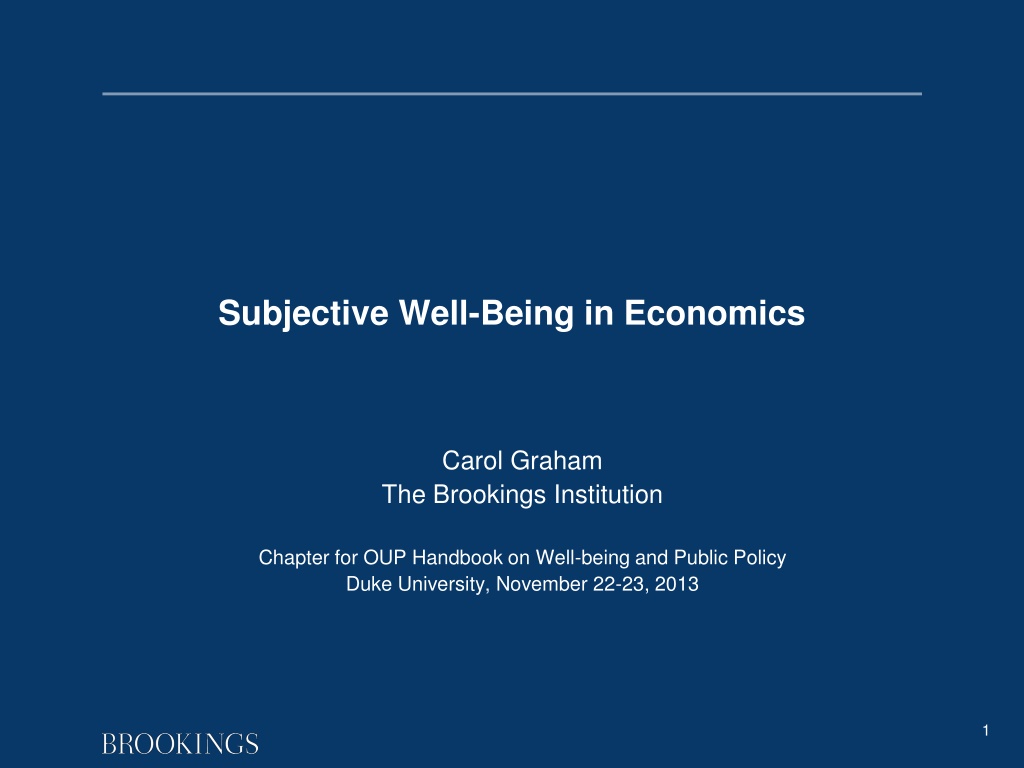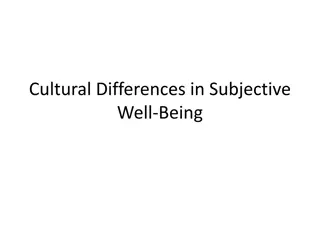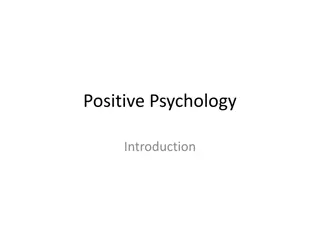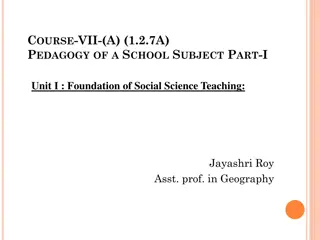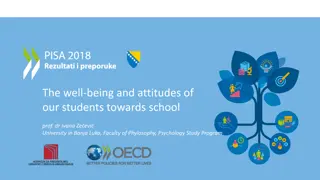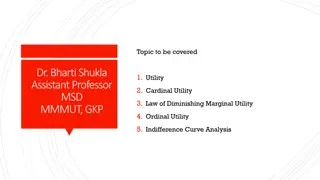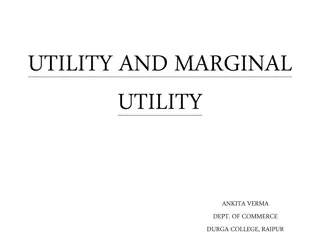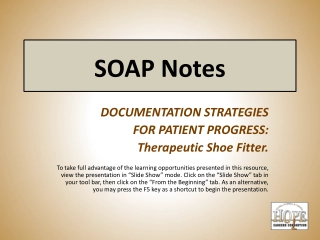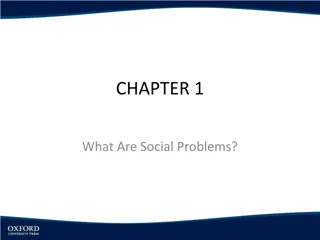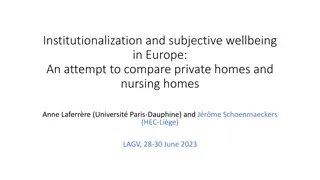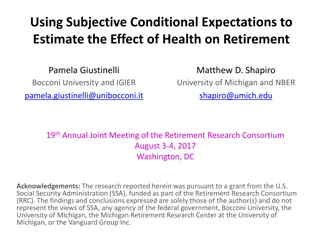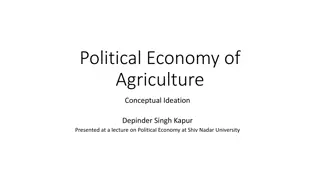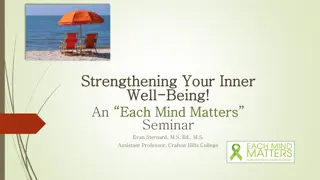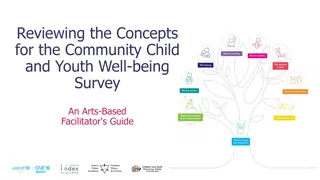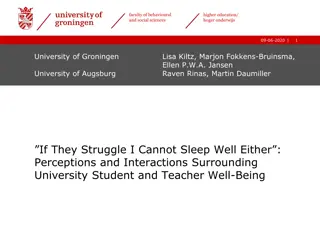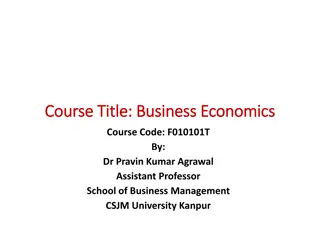Exploring Subjective Well-Being in Economics: A New Science
Delve into the emerging field of happiness economics, which combines economic and psychological methodologies to measure well-being beyond income. Discover the historical roots, methodological innovations, and diverse applications of this interdisciplinary approach in understanding human welfare and policy impacts.
Download Presentation

Please find below an Image/Link to download the presentation.
The content on the website is provided AS IS for your information and personal use only. It may not be sold, licensed, or shared on other websites without obtaining consent from the author. Download presentation by click this link. If you encounter any issues during the download, it is possible that the publisher has removed the file from their server.
E N D
Presentation Transcript
Subjective Well-Being in Economics Carol Graham The Brookings Institution Chapter for OUP Handbook on Well-being and Public Policy Duke University, November 22-23, 2013 1
A new science? Until five or so years ago, I was one of a very small number of seemingly crazy economists using happiness surveys, and surely the only one working on developing economies; since the science of measuring well- being has gone from a nascent collaboration between economists and psychologists to an entire new approach in the social sciences Today - remarkable interest in the topic; momentum, reflects the work of many academics, and experiments like those of Bhutan (and now the UK) that have taken the science and the metrics seriously; OECD guidelines NAS panel on hedonic versus evaluative measures of well-being for policy and relevance of the metrics for policy Can answer questions as diverse as the effects of commuting on well- being, why cigarette taxes make smokers happier, why the unemployed are less unhappy when there are more unemployed people around them, and why people adapt to things like crime and corruption and bad governance. 2
Where did this all come from? Early economists and philosophers, ranging from Aristotle to Bentham, Mill, and Smith, incorporated the pursuit of happiness in their work. Yet, as economics grew more rigorous and quantitative, more parsimonious definitions of welfare took hold. Utility was taken to depend only on income as mediated by individual preferences within a budget constraint. Part of a more general move in economics that challenges these narrow assumptions: bounded rationality, behavioral economics Happiness economics relies on more expansive notions of utility and welfare, including interdependent utility functions, procedural utility, and the interaction between rational and non-rational influences in determining economic behavior. Most recent research distinguishes between hedonic well-being - daily experience and quality of life - and evaluative - well-being over the life course, including opportunities and capabilities, and meaning or purpose in life (eudaimonia). Now is more accurately described as the economics of well-being rather than happiness Newest research aims to understand the causal properties of well- being (and how they vary across well-being dimensions). 3
Why Happiness Economics? Method combines tools and methods of economists with those typically used by psychologists Captures broader elements of welfare than do income data alone Method is uniquely well-suited for analyzing questions where revealed preferences do not provide answers, for example the welfare effects of institutional arrangements individuals are powerless to change (like inequality or macroeconomic volatility) and/or behaviors that are driven by norms or by addiction and self control problems (alcohol and drug abuse, smoking, obesity) While economists traditionally have shied away from reliance on surveys (e.g. what people say rather than what they do), there is increasing use of data on reported well-being (happiness): a) Consistent patterns in the determinants of well being across large N samples across countries and across time b) Econometric innovations help account for error and bias in survey data (AND with error that exists in all kinds of data!!) 4
Terminology The terms happiness, well-being , subjective well-being , and life satisfaction often used inter-changeably in the economics literature; psychologists take much more care in distinguishing the nuances between them. The economics literature is now beginning to distinguish between well-being dimensions: evaluative and hedonic. Happiness: Most open-ended and least well-defined of the terms, although attracts the most public attention. In the U.S. Declaration of Independence. Attempts to gauge how happy feel about their life in general. From an empirical research perspective, it does not impose a definition of happiness on respondents. Life satisfaction correlates very closely with happiness questions, yet slightly more framed and correlates a bit more closely with income. When asked about satisfaction with their lives, people more likely to evaluate their life circumstances as a whole, in addition to happiness at the moment. 5
Terminology (2) Ladder of life question often used interchangeably with happiness. Asks respondents to compare their lives to the best possible life they can imagine (relative component). Responses correlate more closely with income than life satisfaction; most respondents use international reference norm (Afghanistan). Hedonic well-being measures how people experience their daily lives what is their mood (positive or negative/ (smiling or worried yesterday) as they do different things, like commuting to work, spending time with friends, or conducting research/writing Subjective well-being: encompasses all of the ways in which people report their well-being, discussed above Well-being: the most encompassing of all of these terms and implies an evaluation of human welfare that extends beyond the components that income can accurately capture or measure. 6
The Method Despite potential pitfalls and biases (discussed below), cross- sections of large samples across countries and over time find remarkably consistent patterns in the determinants of happiness and life satisfaction. Studies by a wide number of authors and using different data sets for different countries and regions find essentially identical patterns in the determinants of subjective well-being, both across countries and over time. Oswald and Stephen Wu (2010) - based on a random sample of 1.3 million U.S. citizens - compare life satisfaction responses to quality of life patterns estimated from non-subjective data (using compensating differentials approach); find a state by state match between subjective and objective well-being (r= 0.6, P<0.001). Psychologists also find validation in the way that people answer these surveys based in physiological measures of happiness, such as the frontal movements in the brain and in the number of genuine Duchenne smiles; also new work on genes 7
The Method, Continued Micro-econometric well-being equations have the standard form: Wit= + xit+ it W is the reported well-being of individual i at time t, and X is a vector of known variables including socio-demographic and socioeconomic characteristics. Unobserved characteristics and measurement errors in the error term. Because the answers to well-being surveys are ordinal rather than cardinal, use ordered logit or probit equations. These regressions typically yield lower R-squares than economists are used to, reflecting the extent to which emotions and other components of true well-being are driving the results, as opposed to the variables that we are able to measure, such as income, education, and marital and employment status. 8
Methods continued, part 3! Coefficients in ologit/oprobit remarkably similar to those in OLS based on same equations. While impossible to measure precise effects, scholars use OLS coefficients as a basis for assigning relative weights to them. Can estimate how much income a typical individual in the United States or Britain would need to produce the same change in stated happiness that comes from the well-being loss resulting from, for example, divorce ($100,000) or job loss ($60,000) (Blanchflower and Oswald, 2004). These estimates, of course, should be taken as a means to assess orders of magnitude rather than precise income differentials. 9
Age-pattern conforms world-wide! Happiness by Age Level Latin America, 2000 level of happiness 18 26 34 42 50 58 66 74 82 90 98 years of age 10
Happiness patterns across the world Happiness and age (figure) Income Health Employment Friendships Gender (less clear) Because of these consistent patterns, we can then explore the happiness effects of things that vary, such as commuting time, environmental quality, the inflation or unemployment rate, the nature of governance, obesity rates, crime and corruption rates, cigarette smoking, exercise, and more To some extent, the world is our oyster! 11
Happiness and Income per Capita: The Easterlin Paradox? Life Satisfaction and GDP per capita Select countries, 1998-2008 Percent above neutral on life satisfaction (WVS) 100% Netherlands Norway Colombia Sweden Finland Switzerland New Zealand Mexico Spain UK Canada Argentina US Brazil Vietnam JapanAustralia El Salvador Turkey Singapore Italy 80% Saudi Arabia Chile Indonesia South Africa Uruguay Germany Slovenia Nigeria Poland France Peru China South Korea Iran Philippines Czech Rep. 60% Uganda Romania Algeria Hungary Egypt OECD countries in red; Non-OECD countries in blue. Bangladesh Bulgaria 40% R-squared = 0.498 India Zimbabwe Iraq Pakistan Tanzania Belarus 20% 0% 0 5000 10000 15000 20000 25000 30000 35000 40000 45000 50000 GDP per capita, PPP constant 2005 international $ (WDI) Source: Chattopadhyay and Graham (2011) calculations using World Values Survey (for Life Satisfaction) and World Development Indicators, The World Bank (for GDP per capita). 7 12
More on the Easterlin Paradox Depends a lot on what well-being question is used Hedonic Treadmill Set Point Theory Relative Income Differences (size of reference norm matters, signaling issues, status versus income Danes study) Over time findings confounded by non-comparable data sets and time frames as well as adaptation and changing norms and expectations (health, crisis, unpleasant certainty versus certainty, paradox of unhappy growth) 13
Best Possible Life and the Dow Jones Industrial Average Dow and Happiness (2008-2009) 14000 7.2 Best Possible Life (daily average) 12000 7 DJIA (day end) 6.8 10000 6.6 8000 6.4 6000 6.2 01 Jan 08 01 Jul 08 01 Jan 09 Date 01 Jul 09 01 Jan 10 Dow Jones Indus Avg (day end) Best Possible Life (0-10 scale) 14
The paradox of unhappy growth The relationship between income per capita, economic growth, and satisfaction 122 countries GDP per capita Economic Growth Life Satisfaction 0.788 *** -0.082 *** Standard of living 0.108 *** -0.018 *** Health satisfaction 0.017 * -0.017* Job satisfaction 0.077 *** -0.006 Housing satisfaction 0.084 *** -0.006 Source: IADB-RES using Gallup World Poll, 2007 OLS regression; dependent variable is average life satisfaction per country, growth rates are averaged over the past five years. N=122 GDP per capita: The coefficients are the marginal effects: how much does the satisfaction of 2 countries differ if one has 2X the income of the other. Economic Growth: How much does an additional % point of growth affect satisfaction The life satisfaction variable is on a 0 to 10 scale; all others are the percentage of respondents that are satisfied. Graham and Chattopadhyay find similar effects for Latin America, based on individual data rather than country averages 15
Selected Applications Research based on surveys of subjective well-being has focused on a wide range of issues. In chapter, focus on selection that is framed by questions that standard revealed preferences approaches do not fully answer. These include the relationship between income and happiness, inequality and poverty, the effects of macro-policies on individual welfare, and the effects of public policies in a number of arenas. Some studies have attempted to separate the effects of income from those of other endogenous factors, such as satisfaction in the workplace (Chaparro and Lora, 2013). Others have looked at different work arrangements (full versus part-time, post-retirement age in the work-force, and so on), controlling for income (Nikolova and Graham, 2013). 16
Other Applications Macroeconomics of happiness; inflation and unemployment, misery index Political arrangements matter! And procedural utility - participating Effects of taxes: cigarette taxes study - negative financial effects outweighed by positive self-control effects (Gruber/Mullainathan). Other work looks at the life satisfaction effects of environmental degradation (Welsch, 2007); terrorism (Frey, Luechinger, and Stutzer, 2009; Metcalf et al., 2011); and access to information technology (Graham and Nikolova, 2013a), among others. Legal arena - use of well-being metrics to calculate the statistical value of lives? (Adler; Bronsten et al.; Sunstein; Graham). Standard cost-benefit analysis based on contingent evaluations, hypothetical questions about how many life years one would give up for a higher paying, but riskier job, for example. 17
Reverse Causality? People with higher happiness levels tend to perform better in the labour market and earn more income in the future (Graham, Eggers and Sukhtankar, 2004). DeNeve and Oswald (2012) - large panel data for the U.S. Adolescents who report higher life satisfaction or positive affect grow up to earn significantly higher levels of income later in life. Control for family fixed effects, with sibling clusters ; results robust to controls including education, IQ, physical health, self-esteem, and later happiness. Binder and Coad (2011) - panel data and vector-auto-regressions to explore the co-evolution of changes in mental well-being and changes in income, health, marital status and employment status in BHPS data. Increases in well-being associated with subsequent increases in income, marriage, employment, and health variables, while increases in the life-domain variables (except health) tend to be followed by decreases in well-being in subsequent periods, suggesting adaptation dynamics in all domains. 18
Agency and Well-being Which well-being dimension matters to a particular person is in part determined by his/her capacity to pursue a meaningful life. Lacking capacity for instance, due to lack of wealth or education or to strong imposed norms people may place more value on simple, day-to-day experiences, such as friendship and religion. Those with more capacity may have less time and interest in day- to-day experiences, particularly if they are very focused on some overarching objective or achievement. i) Income and experienced vs evaluative well-being in the US (Kahneman and Deaton); income as proxy for agency in life evaluation responses? ii) LatAm: poor and friends/family; rich and work/health (Graham and Lora); work/health = agency, friends/family = safety nets; 19
Research on the causal channels of different dimensions of well-being A) Different dimensions of well-being and major change (e.g. unhappiness and progress?) i) unhappiness and intent to migrate; ii) well-being trends pre- and post- the Arab Spring rebellions B) Different dimensions of well-being and longer-term outcomes/behaviors i) job satisfaction/meaningful work/productivity; ii) different dimensions of well-being and public health outcomes (obesity, discount rates) C) Different behaviors depending on where in the well-being distribution people are? i) happiest respondents value income/employment least but learning and creativity more, for example 20
Methodological Issues and Challenges Causality, unobservables, endogeneity. One approach: controlling for optimism in a cross section; quantile regressions Experiments Benjamin and Heffetz; comparing predicted life satisfaction with choice experiments, among others Question ordering bread and circuses/Deaton example buffering questions why does life satisfaction work? Interview mode (Dolan) people were happier on the phone; less likely to lie about unhappiness face to face; in other cases, people are more likely to report misery anonymously Scaling and labeling issues best to have unipolar scale on the same question, running from not at all to very, rather than different poles; 0-10 scales seem to work well for both EWB and HWB Recall period, day of the week bias 21
Bentham or Aristotle in the statistics offices? Broad agreement among scholars on the two distinct concepts of well-being; each could have implications for policy which, in turn, could vary depending on the country context Jeremy Bentham s concept of welfare - maximizing the contentment and pleasure of the greatest number of individuals as they experienced their lives that is, people feeling happy on a day-to-day basis hedonic or experienced well-being. Aristotle - happiness as eudaimonia: combines two concepts: eu : well-being or abundance, and daimon : the power controlling an individual s destiny. Within the bounds of evaluative well-being; implicitly includes the opportunity to lead a purposeful or meaningful life. Hedonic well-being measures better for assessing QOL and life at the moment; evaluative well-being better for assessing people s capacities to make choices and to seek fulfilling lives 22
Well-Being Metrics in the Economic Policy Realm Much to resolve before agreeing on a single measure of well- being as a benchmark; NAS panel: a single measure may never be appropriate. Yet consensus on low risk of adding a few robust questions to national/international statistics (as ONS has done and the OECD is recommending). Five tried and true questions capture both dimensions of well- being (and can be mapped to more detailed studies, for example, time-use and daily experience studies) These are: Life satisfaction in general terms (happiness or life satisfaction) Happiness in relative terms (best possible life question) Life as experienced on a daily basis, via positive and negative affect questions, such as smiling yesterday, worrying yesterday, and time spent with friends Happiness in the Aristotelian or life purpose sense 23
Concluding Thoughts/Questions Happiness is, in the end, a much more complicated concept than is income. We can compare income across people with clarity on what it seeks to measure. With happiness, in addition to definitional issues, many questions remain: a) Cardinality versus ordinality e.g. reducing misery or raising aggregate levels of well-being? Reducing poverty, for example, is only one objective of macro-economic policy? b) Inter-temporal issues: today s well-being versus the future well- being of children? Policies may not be the same c) What is a meaningful change in well-being? Do we know? How do we translate this for the public? Relevance of hedonic metrics for policy? a) daily experience can undermine longer term objectives (obesity/discount rates, Krueger job search findings, Akerlof gang findings) b) daily experience metrics capture QOL issues, such as end of life decisions In my view, though, evaluative/eudemonic well-being e.g. people s capacity to make choices and to lead fulfilling lives is more directly relevant at least as a policy objective 24
